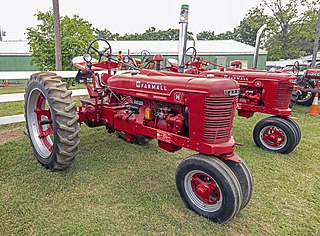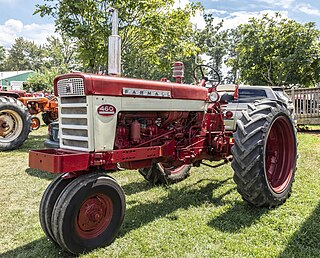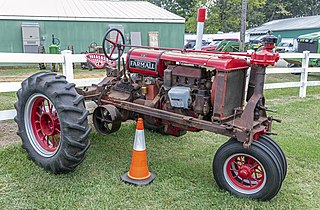
The Massey-Harris Model 101 was a tractor built by Massey-Harris from 1938 to 1946. Developed under the guidance of James S. Duncan, who gambled corporate losses would drop and won, the 101 introduced the Chrysler L-head inline six. The six would compete with Oliver's straight-six Model 70, while saving money on development of a whole new engine as well as taking advantage of Chrysler's existing parts and service network.

The Farmall H is a medium-sized two-plow row crop tractor produced by International Harvester under the Farmall brand from 1939 to 1954. It was the most widely produced of International Harvester's "letter series", with approximately 390,000 produced over the 14-year run. It succeeded the Farmall F-20. The H was incrementally updated with new model numbers as the Super H, 300, and 350, but remained essentially the same machine. The original H used an International Harvester C152 4-cylinder in-line engine. Production of all versions lasted until 1963.

The Farmall M is a large three-plow row crop tractor produced by International Harvester under the Farmall brand from 1939 to 1953. It was of International Harvester's "letter series". It succeeded the Farmall F-30. The M was incrementally updated with new model numbers as the Super M, Super M-TA, 400, and 450, but remained essentially the same machine. The original M used an International Harvester C248 4-cylinder in-line engine. Production of all versions lasted until 1954.

The Farmall B is a small one-plow row crop tractor produced by International Harvester under the Farmall brand from 1939 to 1947. It was derived from the popular Farmall A, but was offered with a narrow set of centerline front wheels instead of the A's wide front axle, allowing two-row cultivation. The operator's seat was offset to the right to allow better forward visibility.

The Farmall A is a small one-plow row crop tractor produced by International Harvester under the Farmall brand from 1939 to 1947. The tractor was popular for its set of innovative features in a small, affordable implement. It succeeded the Farmall F-14. The A was incrementally updated with new model numbers as the Super A, 100, 130 and 140, but remained essentially the same machine. Like the smaller Farmall Cub, the Farmall A features a distinctive offset engine, displaced to the left over wide-set front wheels, to allow vision straight ahead. An International Harvester C113 4-cylinder in-line engine was used for early models, increased to an IH C123 with the A-1. The most significant change was the introduction of hydraulics with the Super A. The series was produced until 1973.

The Farmall 60 series tractors are general-purpose row-crop tractors that replaced the larger models of the Farmall letter series beginning in 1958. Produced from 1958 to 1963, the Farmall 460 and 560 tractors represented a modernization of the Farmall H and Farmall M respectively, with higher-horsepower 6-cylinder engines in a restyled body. The heavy general-purpose 660 was sold under the International brand, and was a successor to the McCormick-Deering W series tractors.

The McCormick-Deering W series tractors were a range of standard-tread farming and industrial tractors produced by International Harvester that were derived from the Farmall letter series row-crop tractors of the 1940s and 1950s. Branded by International Harvester as McCormick-Deering products, with the same styling and red paint as the Farmall line, the W series had fixed wheel widths, lower height and wide front axles. Starting in 1956 the W series was integrated into the International Harvester numbering series and the McCormick-Deering branding was dropped.

The Farmall F-30 is a large three-plow row crop tractor produced by International Harvester under the Farmall brand from 1931 to 1939, with approximately 28,900 produced. It was a larger successor to the Farmall Regular, and was replaced in 1939 by the Farmall M as the largest tractor in the Farmall line.

The Farmall F-20 is a medium-sized two-plow row crop tractor produced by International Harvester under the Farmall brand from 1932 to 1939, with approximately 148,000 produced. It replaced the Farmall Regular, and was itself replaced in 1939 by the Farmall H.

The Farmall F-12 is a small two-plow row crop tractor produced by International Harvester under the Farmall brand from 1932 to 1938, with approximately 123,000 produced. An improved model, the two-plow F-14, was produced beginning in 1938 and ending in 1939, when the Farmall letter series tractors were introduced.

The John Deere Model M tractor was a two-cylinder row-crop tractor produced by John Deere from 1947 to 1952, with successor models produced until 1960. It was succeeded by the updated 40, 420 and 430 models, as well as the 320 and 330 models that occupied the market positions left vacant by the more powerful 400 series models.

The Oliver 70 series of row-crop tractors was a series of large agricultural tractors produced from 1935 to 1967 by the Oliver Farm Equipment Company. Oliver tractors were known for their powerful engines compared to competitors, and their attention to styling. The Oliver Hart-Parr 70 marked the beginning of a strikingly-styled series of tractors that were produced under both the Oliver and the Cockshutt names. Oliver's emphasis on styling strongly influenced offerings by competing brands such as Farmall and John Deere.

The Oliver 60 series of row-crop tractors was a product line of agricultural tractors produced from 1940 to 1964 by the Oliver Farm Equipment Company. The 60 series was a four-cylinder follow-on to the six-cylinder Oliver 70. As the 70 was outsold by the less-expensive Farmall A, Allis-Chalmers Model B and John Deere Model B, Oliver introduced the 60 to compete.
The Oliver 90 series of row-crop tractors was a series of agricultural tractors produced from 1937 to 1961 by the Oliver Farm Equipment Company. Beginning with the Hart-Parr 28–44, the series was the most powerful Oliver tractor offering, capable of heavy plowing. Initial development proceeded on parallel lines, with the 28–44 offered with low and high-compression engine options that became the Oliver 90 and 99, respectively. The lines merged with the Super 99, then diverged again with the 950, 990 and 995 models. The series was produced until 1961.

The Oliver Super 55 series of utility tractors was developed and produced from 1954 to 1958 by the Oliver Farm Equipment Company to complement the Oliver line of heavy row-crop and standard agricultural tracts. Like row-crop tractors, the wheel track width could be adjusted to conform to crop row spacing, but the front wheels were only offered with a wide track. No narrow front wheel options were offered, making the tractor more stable with front-end loaders.

The Cockshutt 40 row-crop tractor was the second tractor produced by the Cockshutt Plow Company, from 1949 to 1958. Having developed the medium-sized Cockshutt 30, Cockshutt developed the heavier 40, using a six-cylinder engine. The 40 was rated for four plows. It was sold in the United States as the CO-OP E4.

The Cockshutt 20 row-crop tractor was the third tractor produced by the Cockshutt Plow Company, from 1951 to 1958. Having developed the medium-sized Cockshutt 30 and the heavier Cockshutt 40, the 20 was a small two-plow tractor for general use. The 20 was sold in the United States as the CO-OP E2.

The Cockshutt 50 row-crop tractor was a row-crop tractor produced by the Cockshutt Plow Company, from 1953 to 1957. It was the largest of a series of Canadian-produced tractors that started with the Cockshutt 30, and was based on the Cockshutt 40 with a more powerful engine. The 50 was a large four or five-plow tractor for general use. The 50 was sold in the United States as the CO-OP E5.
The Cockshutt 550 row-crop tractor was built by the Cockshutt Plow Company, from 1958 to 1961. It succeeded the Cockshutt 35 Golden Arrow in the Cockshutt product line, and was capable of pulling two or three plows. The new tractor was restyled in accordance with the trend toward squared-off lines, compared to earlier Cockshutt offerings. Confusingly, the 550 was replaced in 1962 by a different Oliver-built tractor, also branded as the Cockshutt 550.
The Cockshutt 570 row-crop tractor was built by the Cockshutt Plow Company, from 1958 to 1960. It succeeded the Cockshutt 50 heavy tractor in the Cockshutt product line, and was capable of pulling five plows. The new tractor was restyled in accordance with the trend toward squared-off lines, compared to earlier Cockshutt offerings.


















